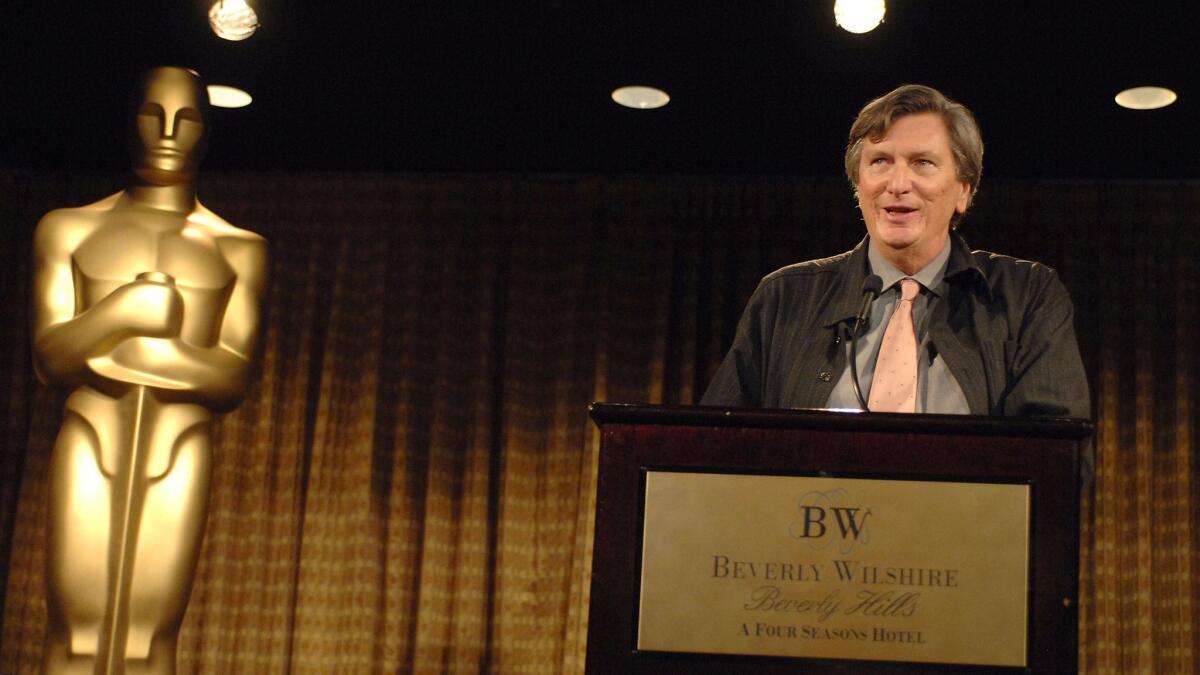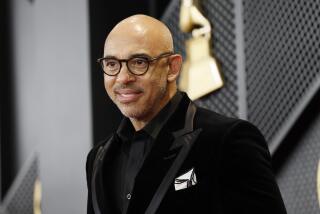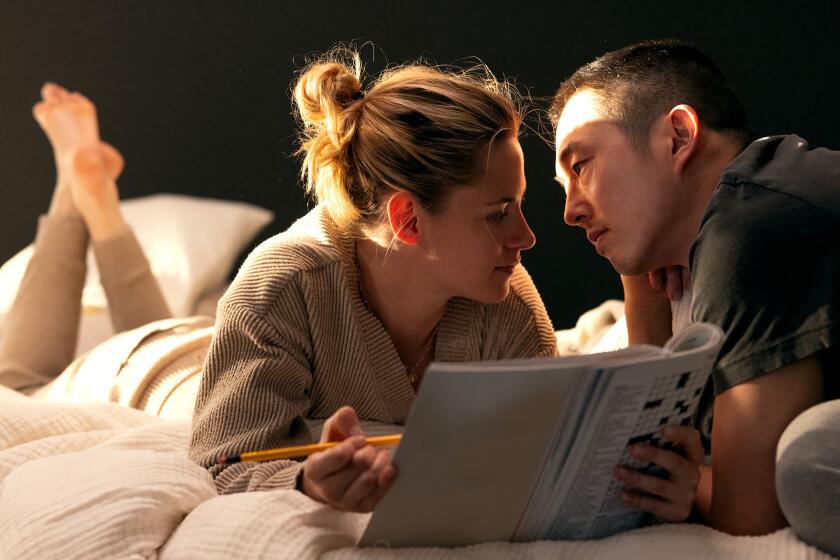What newly elected president John Bailey means for the film academy’s future

- Share via
With the Academy of Motion Picture Arts and Sciences at a crossroads after two years of controversy and turbulence unlike anything in its nearly 90-year history, many within the group’s leadership ranks were looking for a steady hand.
The academy’s 54-member board of governors — including such industry luminaries as Tom Hanks, Kathleen Kennedy, Whoopi Goldberg and Steven Spielberg — gathered Tuesday evening to decide who would succeed outgoing president Cheryl Boone Isaacs, who has led the organization for four transformative and often tumultuous years that included the #OscarsSoWhite firestorm and the recent Oscar-night best picture envelope bungle.
Actress Laura Dern’s name had been floating in the rumor mill for weeks, stirring enthusiasm among those who felt the academy’s public image could use a fresh coat of star-power gloss. But as the meeting progressed, Dern declined her nomination after deciding that the demands of the job would be too difficult to balance with her busy career. The choice ultimately came down to two well-respected veteran academy insiders, each representing the film industry’s often unsung below-the-line workers: casting director David Rubin and cinematographer John Bailey.
Though active campaigning for the job of president is traditionally frowned upon, front-runners inevitably emerge. Bailey’s name had not been among the handful being whispered in the run-up to the election. He had been on the board for 14 years and had served as vice president for three terms, but he had not made a run for presidency before. But when the ballots were counted, the 74-year-old journeyman cinematographer — whose credits include such films as “Ordinary People,” “The Big Chill” and “Groundhog Day” — had prevailed.
Known for his versatility behind the camera, Bailey had never been one to grab the limelight. “I’ve never received an academy nomination or … any kind of, you know, accolade from my peers,” Bailey told the trade magazine Variety in 2015 shortly before receiving the American Society of Cinematographers’ Lifetime Achievement Award. “I think this is by virtue of the kinds of films I do. They’re not necessarily ones that call attention to the cinematography.”
The fact is, in decades past, few outside the academy ever gave much thought to the private deliberations of its leadership, and the office of president, which is unpaid, has traditionally been largely ceremonial. But in recent years, as the academy under the leadership of Boone Isaacs and academy Chief Executive Dawn Hudson has taken a series of dramatic steps to remake itself inside and out, public scrutiny of the organization has grown ever more intense. Having spent his career behind the scenes, Bailey now finds himself the public face of an institution in the process of transforming itself, taking on what some consider one of the toughest and most thankless jobs in Hollywood under the glare of the spotlight.
“Holy mackerel, it’s changed,” Boone Isaacs told The Times in an interview this spring. “We seem to be in the same zone as just about everything, where somehow your day-to-day business is news. It’s bizarre…. I’m assuming that’s not going away.”
Indeed, Bailey immediately inherits a handful of major challenges facing the organization, including an ongoing push to diversify its overwhelmingly white and male membership ranks, an ambitious and costly effort to build an academy museum in Los Angeles and the steady erosion in ratings for the all-important Oscars telecast.
Bailey was unavailable to be interviewed for this story, but insiders say those looking to read the tea leaves about his choice should not get ahead of themselves. Though he is an older white male — and follows Boone Isaacs, the first African American and the third woman to serve as president — his election, the insiders say, was in no way a referendum on the issue of boosting diversity within the academy’s membership and leadership ranks, which will remain a key priority going forward.
In 2016, in response to a growing controversy over its selection for the second consecutive year of an all-white slate of acting nominees, the academy announced a sweeping campaign aimed at doubling the number of women and minorities in its membership by 2020. While the diversity initiative has been widely applauded, it was met early on with sometimes bitter pushback from some older rank-and-file members who felt they were being unfairly tarred with the brush of racism.
I do believe this organization is not going to let it stop. I know Dawn Hudson is not going to let it stop — that’s for sure.
— Cheryl Boone Isaacs on the continued push for diversity
With this year’s best picture victory for “Moonlight” and record number of wins for African Americans across the board, it’s possible the issue of diversity could begin to move toward the back burner, at least in the public’s mind. “That can happen,” Boone Isaacs said. “But I do believe this organization is not going to let it stop. I know Dawn Hudson is not going to let it stop — that’s for sure. And the board is very much committed.”
Hudson, whose contract was recently renewed through June 2020, agreed that the academy’s push toward diversity would not flag. “That commitment [to diversity] has not waned and will not wane for many years to come,” Hudson said. “Because I don’t see this industry getting a lot more diverse or having more gender parity any time real soon. So this work will be ongoing for the academy.”
In the last two years, the academy has opened its doors to the largest and most diverse classes of new members in its history. In June, a whopping 774 industry professionals were invited to join the organization, 39% of whom were female and 30% of whom were people of color, bringing the overall share of women and minorities among the more than 7,000 members to 28% and 13%, respectively. (In a landmark 2012 analysis, The Times reported that Oscar voters at the time were 23% female and 6% nonwhite.)
Certain branches have seen more progress toward diversity than others, however, reflecting deeper inequities in hiring in different segments of the film industry. The cinematographers’ branch in particular has historically been overwhelmingly male and white, though it has made strides in the last two years to invite more women and nonwhites, including Caroline Champetier (“Holy Motors”), Camilla Hjelm Knudsen (“Land of Mine”) and Chung-Hoon Chung (“Me and Earl and the Dying Girl”).
Nor, insiders say, should Bailey’s election be seen as a referendum on the leadership of Hudson, who has at times been a polarizing figure within the board over what some view as her hard-charging style, in particular her stewardship of the museum, which has run into repeated delays and cost overruns and is currently projected to open in 2019. As he helps steer the academy forward, Bailey — who has a reputation for being well-connected and deeply familiar with the ins and outs of the academy — will have to work closely with Hudson.
For Bailey – whose tenure will be limited to a maximum of two years due to his prior years of service on the board – leading a proudly tradition-bound institution in the process of giving itself a makeover in full public view will undoubtedly bring its share of challenges. But speaking to The Times in May as her tenure was winding down, Boone Isaacs said she was confident that whoever took the reins as the next president would have the skills needed to lead the institution forward.
“Listen, this organization was great before I took this position, and it’ll be great after I leave,” she said. “It’s just an evolution of change, and this is an exciting time.”
Twitter: @joshrottenberg
More to Read
Only good movies
Get the Indie Focus newsletter, Mark Olsen's weekly guide to the world of cinema.
You may occasionally receive promotional content from the Los Angeles Times.










